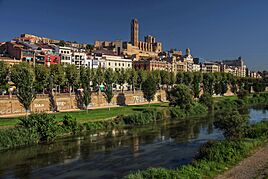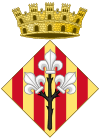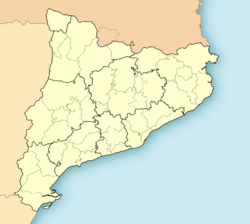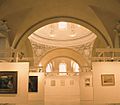Lleida facts for kids
Quick facts for kids
Lleida
|
|||
|---|---|---|---|
|
Municipality
|
|||
|
|
|||
|
|||
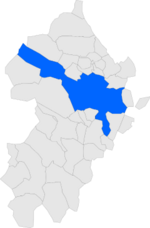
Location in Segrià county
|
|||
| Sovereign state | |||
| Community | |||
| Region | Ponent | ||
| County | Segrià | ||
| Province | Lleida | ||
| Founded | 6th century BC | ||
| Government | |||
| • Type | Mayor-Council | ||
| Area | |||
| • Total | 212.3 km2 (82.0 sq mi) | ||
| Elevation | 155 m (509 ft) | ||
| Population
(2022)
|
|||
| • Total | 140,797 | ||
| • Density | 663.20/km2 (1,717.7/sq mi) | ||
| Time zone | UTC+1 (CET) | ||
| • Summer (DST) | UTC+2 (CEST) | ||
| Postal code |
25001-25007
|
||
| Dialing code | 34 (Spain) + 973 (Lleida) |
||
| Official language(s) | Catalan, Spanish | ||
| Climate | BSk | ||
Lleida is a historic city in western Catalonia, Spain. It is the capital and largest city in the Segrià area. Lleida is also the main city of the Ponent region and the Province of Lleida. The city is located in the Catalan Central Depression. In 2022, about 140,797 people lived there.
Lleida is one of Catalonia's oldest cities. People have lived here since the Bronze Age. Before the Romans arrived, the Ilergetes, an ancient Iberian tribe, lived here. The Romans named the city Ilerda. It was under Muslim rule from the 8th century until it was taken back in 1149. The University of Lleida was founded in 1297, making it one of Spain's oldest universities. The city has grown a lot since the 20th century.
Contents
Understanding the Name of Lleida
The city's name is Lleida in Catalan. In Spanish, it is called Lérida. Both names are used, but the Catalan name Lleida is the official one. This is because the Spanish name was often used during a time when the Catalan language was not allowed.
A Look at Lleida's Past
Lleida has a very long and interesting history. It was once known as Iltrida and Ilerda.
Ancient Times and Roman Rule
In ancient times, Lleida was the main city of the Ilergetes tribe. Their kings, Indíbil and Mandoni, bravely defended the city. They fought against invaders from Carthage and Rome.
Under the Romans, Lleida became an important city. It was part of the Roman province called Hispania Tarraconensis. The city was built on a hill next to the Sicoris River. This location was very important for controlling the area.
The Battle of Ilerda
In 49 BC, during the Roman Civil War, Lleida was a key battleground. Pompey's generals used the city as a strong defense point against Julius Caesar. Caesar's army surrounded the city in what is known as the Battle of Ilerda. Even though the land favored his enemies, Caesar's clever strategies led to his victory. This battle is a famous example of military skill.
After the Romans won, Ilerda became a rich city. It even made its own coins. The Romans built a strong stone bridge over the Sicoris River. Parts of its foundations are still used for a bridge today!
Middle Ages and Beyond
Lleida was part of the Visigothic kingdom and later Muslim Spain. In 1149, Count Ramon Berenguer IV of Barcelona took the city back from the Moors.
Lleida was home to a very important university, the oldest in the Crown of Aragon. However, in 1717, King Philip V moved it to the nearby town of Cervera. Luckily, the University of Lleida reopened in 1991.
Wars and Growth
During the Reapers' War in the 17th century, French and rebel forces occupied Lleida. Later, Spanish forces took it back in 1644.
Lleida was also important during the Spanish Civil War. It helped defend Barcelona. The city faced many bombings in 1937 and 1938. A sad event happened on November 2, 1937, when a school called Liceu Escolar de Lleida was bombed. Many children and teachers lost their lives.
After the war, many people from Andalusia moved to Lleida. This helped the city grow again. Today, people from 146 different countries call Lleida home. In 2007, Lleida was chosen as the Capital of Catalan Culture.
Jewish History in Lleida
The Jewish quarter in Lleida, also called La Cuirassa, dates back to the 11th century. It was located near the city wall. A street named "Judería" still exists in Lleida today, reminding us of this history.
An ancient mikveh, or Jewish ritual bath, was found in Lleida. It dates back to the 9th century and is one of the oldest in Europe.
Lleida's Climate
Lleida has a temperate semi-arid climate. This means it has mild and often foggy winters. Summers are hot and dry. Frosts are common in winter, but snow falls only about one or two days a year. The city doesn't get much rain, with an average of 342 mm (13.5 inches) per year. The most rain falls in spring (April-May) and autumn (September-October).
| Month | Jan | Feb | Mar | Apr | May | Jun | Jul | Aug | Sep | Oct | Nov | Dec | Year |
|---|---|---|---|---|---|---|---|---|---|---|---|---|---|
| Record high °C (°F) | 23.5 (74.3) |
23.4 (74.1) |
28.5 (83.3) |
33.0 (91.4) |
35.0 (95.0) |
43.4 (110.1) |
43.1 (109.6) |
40.8 (105.4) |
37.2 (99.0) |
32.5 (90.5) |
26.0 (78.8) |
20.6 (69.1) |
43.4 (110.1) |
| Mean daily maximum °C (°F) | 10.0 (50.0) |
13.8 (56.8) |
18.3 (64.9) |
20.7 (69.3) |
25.0 (77.0) |
29.8 (85.6) |
33.0 (91.4) |
32.4 (90.3) |
27.8 (82.0) |
22.0 (71.6) |
14.9 (58.8) |
9.8 (49.6) |
21.5 (70.7) |
| Daily mean °C (°F) | 5.5 (41.9) |
7.7 (45.9) |
11.3 (52.3) |
13.7 (56.7) |
17.9 (64.2) |
22.3 (72.1) |
25.2 (77.4) |
24.9 (76.8) |
20.9 (69.6) |
15.9 (60.6) |
9.7 (49.5) |
5.7 (42.3) |
15.0 (59.0) |
| Mean daily minimum °C (°F) | 0.9 (33.6) |
1.6 (34.9) |
4.2 (39.6) |
6.7 (44.1) |
10.8 (51.4) |
14.7 (58.5) |
17.4 (63.3) |
17.4 (63.3) |
13.9 (57.0) |
9.7 (49.5) |
4.4 (39.9) |
1.5 (34.7) |
8.6 (47.5) |
| Record low °C (°F) | −14.2 (6.4) |
−7.6 (18.3) |
−7.0 (19.4) |
−2.2 (28.0) |
0.5 (32.9) |
6.0 (42.8) |
9.5 (49.1) |
7.1 (44.8) |
3.7 (38.7) |
−1.5 (29.3) |
−7.5 (18.5) |
−9.5 (14.9) |
−14.2 (6.4) |
| Average precipitation mm (inches) | 26 (1.0) |
15 (0.6) |
21 (0.8) |
39 (1.5) |
42 (1.7) |
27 (1.1) |
12 (0.5) |
18 (0.7) |
41 (1.6) |
43 (1.7) |
30 (1.2) |
24 (0.9) |
342 (13.5) |
| Average precipitation days (≥ 1.0 mm) | 4 | 3 | 4 | 5 | 6 | 4 | 2 | 2 | 4 | 5 | 4 | 4 | 46 |
| Average relative humidity (%) | 81 | 71 | 62 | 59 | 58 | 53 | 52 | 56 | 63 | 73 | 80 | 84 | 66 |
| Mean monthly sunshine hours | 116 | 162 | 226 | 248 | 282 | 321 | 356 | 319 | 256 | 195 | 135 | 96 | 2,712 |
| Source 1: Agencia Estatal de Meteorologia | |||||||||||||
| Source 2: Periodico El Pais | |||||||||||||
Lleida's Neighbourhoods
Lleida is divided into different areas called districts or neighbourhoods. Here are some of them:
- Balàfia
- Les Basses d'Alpicat
- La Bordeta
- Butsènit
- Camp d'Esports
- Cappont
- Centre Històric
- Ciutat Jardí
- Humbert Torres
- Instituts-Templers
- Joc de la Bola
- Llívia
- Magraners
- Mariola
- Pardinyes
- Príncep de Viana-Clot
- Rambla Ferran-Estació
- Secà de Sant Pere
- Torres de Sanuí
- Universitat
Getting Around Lleida
Lleida has good transport links, making it easy to travel around the city and to other places.
Train Travel
Lleida is on the Madrid-Barcelona high-speed rail line. This means you can take fast trains to cities like Barcelona, Zaragoza, and Madrid. The main train station is Lleida Pirineus. It serves both national and regional train lines. There are plans for a new local train network called Rodalies Lleida. This will connect Lleida with nearby towns in its province.
Bus Services
Lleida has a network of yellow and blue city buses. These buses cover many routes, helping people get to different parts of the city. There are also special buses, like a tourist bus and a night bus service.
Lleida-Alguaire Airport
The Lleida-Alguaire airport opened in 2010. It helps connect Lleida to other areas by air.
Future Transport Plans
There are plans for a new tram-train system. This system would use existing train lines to connect Lleida with Balaguer. It aims to improve public transport both within the city and between towns.
Languages Spoken in Lleida
Lleida is a city where Catalan is traditionally spoken. The local dialect is called Northwestern Catalan or lleidatà. Most people in Lleida also speak Spanish. Many residents are bilingual, meaning they can speak both languages.
| Largest groups of foreign residents | |
| Nationality | Population (2022) |
|---|---|
| 6,249 | |
| 5,014 | |
| 1,578 | |
| 1,489 | |
| 1,444 | |
Lleida's Culture and Arts
Lleida was the Capital of Catalan Culture in 2007. This shows how important arts and traditions are to the city.
Music and Theatre
The Enric Granados Auditorium is Lleida's main concert hall. It's named after a famous composer born in the city. The Teatre Municipal de l'Escorxador is the city's main theatre. A new theatre and congress center, La Llotja de Lleida, opened in 2010.
Festivals and Films
Lleida hosts two important music festivals: the MÚSIQUES DISPERSES Folk Festival in March and the JAZZ TARDOR festival in November. The city also has a Latin-American film festival and an animation film festival called Animac.
Art and Museums
The Lleida Museum opened in 2008. It shows historical items and art from different time periods. The Institut d'Estudis Ilerdencs is a historic building that displays both old and modern art. The Museu d'Art Jaume Morera focuses on art from the 20th and 21st centuries.
Lleida also has smaller galleries and places dedicated to local artists. The Escola Municipal de Belles Arts offers higher education in the arts.
Traditional Celebrations
Lleida has many fun traditional celebrations. The main annual city festival is called Festa Major. There's also the Fira de Sant Miquel and L’Aplec del Caragol.
The Snail Festival
L’Aplec del Caragol is a famous festival where people eat escargot (snails)! It's the biggest snail-eating festival in the world and has been held since 1980. Thousands of people gather to enjoy traditional snail dishes. This festival is so popular that it was declared a national interest in Catalonia and Spain.
The main traditional events in Lleida are led by the "Gegants de la Paeria" (Giants of the Town Hall). These are twelve giant figures, with the oldest ones made in 1840.
Places to See in Lleida
Lleida has many interesting sights, from ancient buildings to modern parks.
- La Seu Vella: This old cathedral is a mix of Romanesque and Gothic styles. It was later used as a military fortress. Nearby are the remains of the Palau de la Suda, an old royal palace. Both are on the Turó de la Seu hill, which overlooks the city.
- La Seu Nova: This is the city's baroque-style cathedral, built later than the old one.
- Institut d'Estudis Ilerdencs: This beautiful Gothic building was once a hospital. Today, it's a museum and research center. You can see historical art and items from different periods.
- La Paeria: This is the city council building. It's also a historical site with remains from Roman, Moorish, and medieval times. You can even see old prison cells.
- Gardeny Castle: This fortress was built by the Knights Templar in the 12th and 13th centuries.
- Camps Elisis: These gardens have been used since Roman times. They feature the lovely Mermaid Fountain.
- La Mitjana: A park with wild areas next to an old dam on the river Segre.
- Church of Sant Llorenç: A 12th-century Romanesque church with later Gothic additions.
- Church of Sant Martí: Another 12th-century Romanesque church.
- Bishop's Palace: Located on Rambla d'Aragó, this palace also serves as an art museum. It displays art from Romanesque to Baroque times.
- El Roser: A 13th-century convent that has been turned into a luxury hotel.
- Lleida Public Library: Found on Rambla d'Aragó, in a building that was once an orphanage.
- Museum of Lleida: Opened in 2008, this museum focuses on the city's history.
- Museu d'Art Jaume Morera: An art museum showing 20th and 21st-century art in a modernist building.
- Auditori Enric Granados: Lleida's main concert hall. Ancient ruins can be seen in its basement.
- La Llotja de Lleida: A modern concert hall, theatre, opera, and congress center opened in 2010.
- Parc de l'Aigua: A large urban park in the southern part of the city.
Sports in Lleida
Lleida has a strong sports spirit.
- Lleida Esportiu: This is the city's main football club, founded in 2011.
- CE Lleida Bàsquet: This is the city's basketball team.
Sister Cities
Lleida has special "sister city" relationships with other places around the world. These connections help promote cultural exchange and friendship.
 Ferrara, Italy
Ferrara, Italy Foix, France
Foix, France Hefei, China
Hefei, China Lérida, Colombia
Lérida, Colombia Perpignan, France
Perpignan, France Monterey, California, United States
Monterey, California, United States
Famous People from Lleida
Many notable people have connections to Lleida:
- Jaume d'Agramunt (?–1350): A Catalan doctor and writer.
- Joan Oró (1923–2004): A biochemist who researched the origin of life.
- Trini Tinturé (born 1935): A cartoonist and illustrator.
- Sergej Milinković-Savić (born 1995): A professional footballer.
Images for kids
-
Romanesque church of Sant Martí
See also
 In Spanish: Lérida para niños
In Spanish: Lérida para niños


